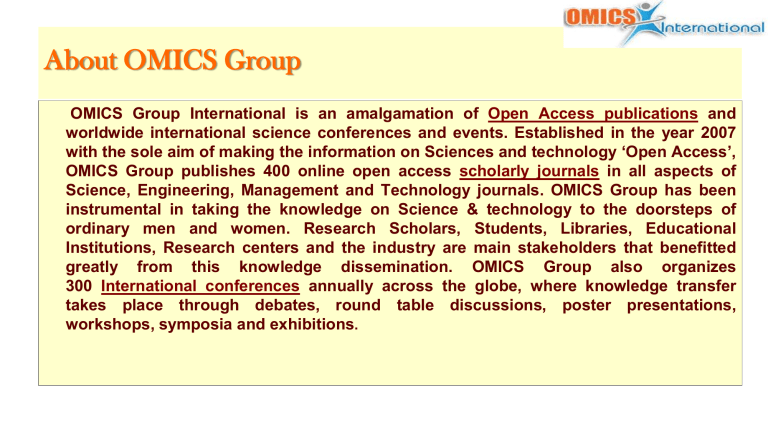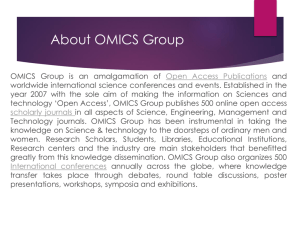annually across the globe, where knowledge transfer takes place

About OMICS Group
OMICS Group International is an amalgamation of Open Access publications and worldwide international science conferences and events. Established in the year 2007 with the sole aim of making the information on Sciences and technology ‘Open Access’,
OMICS Group publishes 400 online open access scholarly journals in all aspects of
Science, Engineering, Management and Technology journals. OMICS Group has been instrumental in taking the knowledge on Science & technology to the doorsteps of ordinary men and women. Research Scholars, Students, Libraries, Educational
Institutions, Research centers and the industry are main stakeholders that benefitted greatly from this knowledge dissemination.
OMICS Group also organizes
300 International conferences annually across the globe, where knowledge transfer takes place through debates, round table discussions, poster presentations, workshops, symposia and exhibitions .
About OMICS Group Conferences
OMICS Group International is a pioneer and leading science event organizer, which publishes around 400 open access journals and conducts over 300 Medical, Clinical,
Engineering, Life Sciences, Pharma scientific conferences all over the globe annually with the support of more than 1000 scientific associations and 30,000 editorial board members and 3.5 million followers to its credit.
OMICS Group has organized 500 conferences, workshops and national symposiums across the major cities including San Francisco, Las Vegas, San Antonio, Omaha,
Orlando, Raleigh, Santa Clara, Chicago, Philadelphia, Baltimore, United Kingdom,
Valencia, Dubai, Beijing, Hyderabad, Bengaluru and Mumbai.
Consecutive vortex ring formation from a pulsed jet
Zachary Garcia zagarcia@alaska.edu
Jifeng Peng
What is a vortex ring?
A vortex ring is a ring-shaped mass of moving fluid which has rotational motion around an axis disposed in circular form
Streamlines on the symmetry plane
Actuator controlled piston
Experimental Setup
Laser sheet
U p t p t
G
Piston velocity
time
U p
D
Quantitative flow measurements
Use digital particle image velocimetry (DPIV) to measure velocity field
Neutrally buoyant glass beads
(mean size: 14 micron )
Laser
Particle movement between frames
Camera
Circulation vs. Time
Δt
Trailing vortex after
Shedding
Shedding
Conclusion
• Examines the formation of consecutive vortex rings with varying size and frequency
• Quantifies the momentum transfer by evaluating the fluid circulation within the rings using DPIV
• Relates the time to maximum formation, Δ t, to the time gap between rings
Zachary Garcia zagarcia@alaska.edu











